
A word of explanation: This page was originally conceived of as an Attracting Wildlife page. Because some people aren't interested in drawing mammals or other critters to their yard, I changed it to focus more on attracting pollinators; however, I retained a few bird and mammal photos for folks who appreciate other kinds of wildlife.
We were honored when our garden and some of its inhabitants were featured in two wildlife habitat gardening articles in the Arizona Daily Star (above) 10 January 2010, and again in 2013. Recently, some of Karen's photos from our yard were included in The North American Butterfly Association's book Butterfly Gardening (Hurwitz 2018).
People living in the Southwest should have little trouble bringing pollinators and other native wildlife into their yards. Even modest plantings can offer food, cover, shelter, and perching sites and will add color to your yard. A patch of unmanicured ground may provide nest sites for pollinating bees. Add a small water feature and you find yourself attracting birds, butterflies and dragonflies. Below are a few pictures from our pond area, a bee box, and some of the plants we've found to be useful attractants for bees, butterflies and hummingbirds. At the bottom of the next page are some web sites that may be helpful as you attract pollinators and other animals to your yard.
Attract Pollinators II
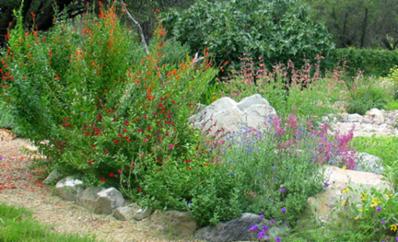
This island of plantings outside the kitchen window provides plenty of food for butterflies and hummingbirds (20 August 2006).

Probably the most important bird attractant in the yard, our small pond also hosts mammals, butterflies, dragonflies and other aquatic insects, beetles, and other life forms. Its flexible liner extends under the beach area in the foreground where shallow water over gravel creates a popular spot for birds to bathe and drink.

This island of plantings outside the kitchen window provides plenty of food for butterflies and hummingbirds (20 August 2006).

Probably the most important bird attractant in the yard, our small pond also hosts mammals, butterflies, dragonflies and other aquatic insects, beetles, and other life forms. Its flexible liner extends under the beach area in the foreground where shallow water over gravel creates a popular spot for birds to bathe and drink.

The beautiful male Desert Firetail (Telebasis salva) is one of more than 25 species of dragonflies and damselflies we have found at our backyard pond. (5 October 2006).
l
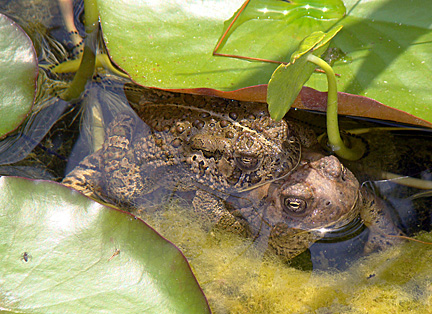
Beginning as early as May, we hear Woodhouse's Toads calling at the pond. Here a female is being fertilized as she lays eggs (visible as a string of tiny black dots at the upper left (16 June 2013).
i

A male Montezuma Quail takes a drink at the pond (25 July 2006).

During spring migration the pond yields an ever changing assortment of birds. Here, three (of five present) Black-throated Gray Warblers take a bath (30 April 2010).

We had anticipated the presence of Ringtails in the yard but it was nine years before one was documented for the property. Karen snapped this one as it foraged just outside the back door during the wee hours of the morning (5 November 2012).

Along with birds, a few mammals visit our small pond. Here, a rather confiding Bobcat comes in for a late afternoon drink (Karen LeMay photo: 16 May 2007).

We frequently see a Gray Fox or two at night. This one surprised us when it came in for a mid-afternoon drink at the pond (20 June 2009).
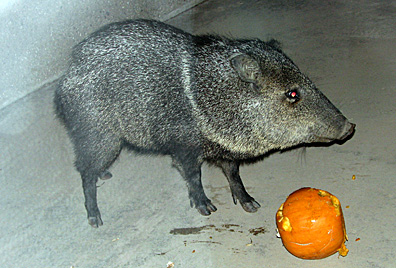
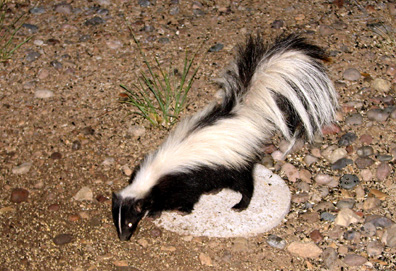

Mason Bees (Osmia spp.) fly for a few weeks early in the spring. Nesting females are easily attracted to holes drilled in a block of wood. Ours utilized cavities in our firewood as well (2 February 2009).

Mason Bees (Osmia spp.) fly for a few weeks early in the spring. Nesting females are easily attracted to holes drilled in a block of wood. Ours utilized cavities in our firewood as well (2 February 2009).


Here is our very simple bee box - scrap wood that escaped the wood stove (L). This hole (R) has been provisioned with eggs then packed shut with chewed vegetation (18 March 2009). To learn how to build simple nests for native bees, click here

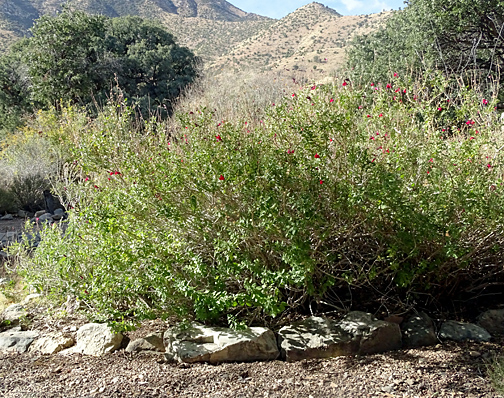
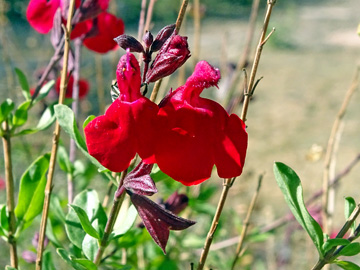
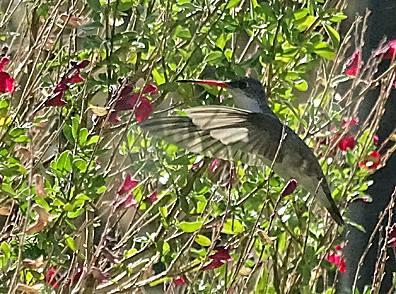
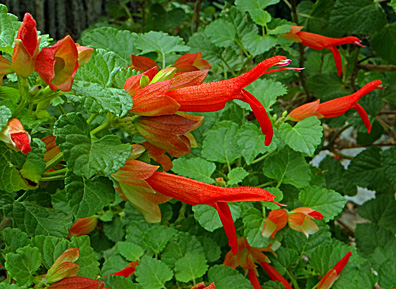

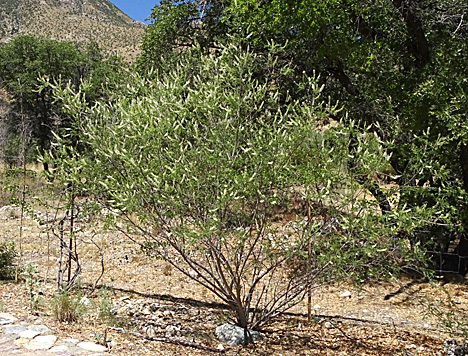
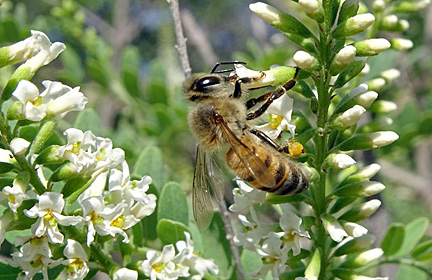

The statuesque Basketflower (10 August 2005) is a butterfly magnet. Eventually, we removed it from our garden because it requires a fair amount of water. Try planting it in a bog garden.


Although guilty of being generic, Zinnia (L) is showy and attracts many butterflies (10 August 2005); Verbena pulchella (30 August 2004) (R) grows quickly, needs little water and nearly all the butterflies nectar at it.

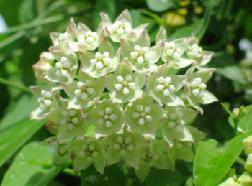
Creeping Lantana (Lantana montividensis) (1 July 2004) (L) and Vine Milkweed (Sarcostemma cynanchioides), a late summer blooming perennial (23 August 2005) (R). Both attract large and small butterflies.
 |  |
Verbena macdougalii is a tall, richly colored Southwestern native. It isn't the butterfly attractant of other verbenas but it's fun to look at and takes care of itself (2 July 2007).

The southwestern native Wooly Butterfly Bush (Buddleia marrubifolia) produces unusual balls of flowers that provide color and butterfly nectar (9 July 2005). During late 2015, this shrub hosted three locally rare Silver-banded Hairstreaks.

Coneflower (Echinacea) is both showy and an excellent nectar plant for butterflies, bees and lycid beetles (2 July 2007). On the down side, plants need a frequent sip of water. 

Vitex or chaste tree is native to the Old World (above two images). With little water, this plant went from a gallon-size transplant to an eight foot-tall shrub in about five years. It may be grown with a bushy form or pruned into a tree-as is often done at the local shopping malls. Vitex attracts butterflies and is a favorite of Carpenter bees (23 June 2010).


Lindheimer or Velvet Leaf Senna (Senna lindheimeriana) is a showy, perennial shrub that needs little water. During winter it gets cut back to about eight inches tall. Each year, a few new ones appear. A host plant for Cloudless Sulphur and Sleepy Orange, it also provides nectar for other species (9 August 2006).

Hesperaloe parviflora "Red Yucca" is a common landscaping plant, often seen in highway medians. A plant may produce numerous stalks that are about 4-5 feet tall. Plants require little water and are hardy to 0 degrees f. Red Yucca is a favorite of hummingbirds which profit from its long blooming period (24 May 2010). Unfenced Hesperaloes may be nipped by deer. Plant several in a clump for the most dramatic floral display. For more information, search for: Hesperaloes: Aloes of the West by Greg Starr.

Hesperaloe nocturna is, as its name implies, a night-blooming plant that's pollinated by bats and sphinx moths. During the day, ours are frequently visited by Broad-billed Hummingbirds. Plants produce fewer stalks that grow to 12 feet in height. This stalk appears horizontal because I had to pull it over for a photo (24 May 2010).

Hesperaloe campanulata or Bellflower Hesperaloe is native to NE Mexico. It has a long, whippy flower stalk and pale pink blossoms. (19 May 2012).


Desert Willow (Chilopsis linearis) is a SW native that grows only 1/4 mile from the house. In the wild it's often a loose, multi-trunked shrub but can be pruned into an attractive tree. Native populations such as those in our neighborhood generally have pinkish-white blossoms; we opted for this purple cultivar (two shots above). The plant provides nectar for hummingbirds and is a host plant for the Rustic Sphinx Moth which has a spectacular hotdog-sized caterpillar (29 May 2010).

Cardinal flower (Lobelia cardinalis) is a richly colored pond plant that attracts hummingbirds, butterflies, and moths such as this White-lined Sphinx (Hyles lineata) (20 September 2004) (Karen LeMay photo).


The four-foot tall, showy and rather snapdragon-like Penstemon palmeri attracts carpenter bees but isn't a hummingbird magnet as are the Penstemons with red tubular blossoms (7 May 2007).

Sundrops (Calylophis hartwegii) is a native that provides a burst of color from late April through late summer. Like many primroses, it attracts sphinx moths (8 April 2007).

Pipevine (Aristolochia watsonii), here in flower, is an easy to miss, low growing plant that provides the Pipevine Swallowtail with its distasteful toxins (28 June 2006). 
Eggs of the Pipevine Swallowtail on Aristolochia watsonii (15 March 2009).

A large Pipevine Swallowtail caterpillar that's about ready to pupate munches on Pipevine (29 August 2010). 
Whatever you call Asclepias curassavica, Scarlet Milkweed, Blood Flower, or Butterfly Flower, it's a fine butterfly attractant, as well as a host plant for the caterpillars of Queens and Monarchs (4 July 2006) (Karen LeMay photo). 

Pineleaf Milkweed (Asclepias linaria) (upper two photos) is native to rocky slopes of southern Arizona and Mexico. Especially high in toxins, it isn't a great host plant for caterpillars of Monarchs or Queens. It forms a 3' tall somewhat woody shrub whose slim stems sway with any breeze. Plants bloom several times per year, offering butterflies and other nectaring insects hundreds of clusters of white flowers. Arrange several plants in a clump for the richest display of blossoms (14 May 2010). Just above, a Gray Hairstreak nectars on its blossoms (16 May 2010). 
Sometimes all it takes to attract butterflies is a spot of soil that was just watered. Here, wet dirt brought in this puddle party of Tailed Oranges and Mexican Yellows (25 September 2008). 
Plants aren't the only things that respond to drip irrigation. Montezuma Quail (24 July 2006) (Karen LeMay photo).
Continue to Attract Pollinators II
